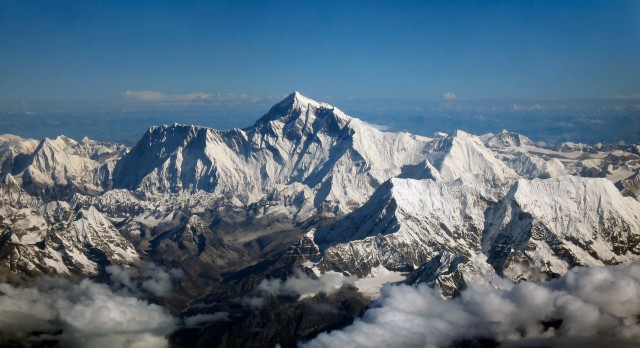Everest, Mount
A PEAK ON THE CREST of the Great Himalayan range in Asia, Everest is the highest point on the Earth. It lies in the Central HIMALAYAS on the border between NEPAL and CHINA (Tibet). Three barren ridges, the southeast, northeast and west culminate in two summits at Everest (29,028 ft or 8,848 m) and South Peak (28,700 ft or 8,748 m). The mountain can be seen directly from its northeastern side where it rises about 12,000 ft (3600 m) above the plateau of Tibet. It claims an incredible view from the top. The formerly accepted elevation of 29,028 ft (8,848 m) established in the early 1950s was recalculated in the late 1990s as 29,035 ft (8,850 m). Its identity as the highest point on the Earth's surface was not recognized until 1852, when the Survey of India, a government organization established that fact. In 1865, the mountain, previously referred to as Mountain Monarch or Peak XV, was renamed for Sir George Everest, a Welshman, who was the surveyor general of India from 1830 to 1843.

The summit itself consists of rock-hard snow; surrounded by a layer of snow that fluctuates annually by some 5 to 7 ft (1.5 to 2 m). It is highest in September and lowest in May, after depletion by the strong northwesterly winter winds. Though the exact thickness of snow atop Mount Everest remains a mystery for scientists around the world, the measure taken by an Italian mountaineering team was more than 8 ft (2.5 m). Individual glaciers around Mount Everest are the Kangshung Glacier (east), Rongbuk (north and northwest), the Pumori (northwest), the Khumbu (west and south) and an enclosed valley of ice between Everest and the Lhotse-Nuptse ridge. The mountain's drainage pattern radiates to the south, west, north, and east. The glaciers melt into rivers flowing towards Tibet and Nepal. Precipitation falls as snow during the summer monsoons (May to September). Lack of oxygen, powerful winds, and extremely cold temperatures preclude the development of any plant or animal life on the upper slopes. At the summit of Mt. Everest, atmospheric pressure is only 30 percent that of sea level, so the climbers take in only 30 percent as much oxygen (and thus need to carry oxygen tanks). There are no permanent settlements here because no one can adjust yearround to such high altitudes.
Attempts to climb Everest began with the opening of the Tibetan route in 1920. Everest was finally surmounted in 1953 as a result of efforts by an expedition sponsored by the Royal Geographical Society and the joint Himalayan Committee of the Alpine Club. On May 29, 1953, Edmund Hillary and Tenzing Norgay became the first to reach the top of the world's highest peak. Since then, 1,200 men and women from 63 nations have reached the summit. Nearly 200 others have perished in the attempt. Japanese woman climber Junko Tabei in 1975 became the first woman to summit Everest. The South Col route to Everest is the most popular and used by more climbers than any other path. The north ridge route begins in Tibet. At the foot of Mount Everest, Rongpu Gompa is the highest monastery in the world. The local people revere the mountain. Its Nepali name (Sagar matha) and Tibetan name (Qomolangma) mean “Goddess mother of the world.” The Sherpas, an ethnic group of the Khumbu valley beneath Everest, urge their clients to ask the mountain deity's blessings with offerings of rice and incense at base camp. Buddhist legend holds that Everest is home to a goddess bearing a bowl of food and a mongoose spitting jewels. Everest has indeed brought prosperity to the region.
The first ascent of Mount Everest sparked a tourism boom that draws more than 20,000 visitors each year to hike amidst the planet's tallest peak. The 50th anniversary of the first ascent of Everest was celebrated in May 2003. Efforts at cleaning up the Everest slopes started in 1994, and more than 20,000 pounds of garbage have been hauled off the peak. Sherpas are paid to bring down used oxygen bottles and other trash.
A Chinese survey has revealed that the world's highest peak is gradually losing its height because of global warming and the shrinking of glaciers in the Himalayan region. According to a scientific survey report released at a recent international symposium held in Lhasa, Tibet, the mountaintop declined by 4.2 ft (1.3 m) in the 33 years ending in 1999. Global warming accelerates the process of conversion from snow to ice.